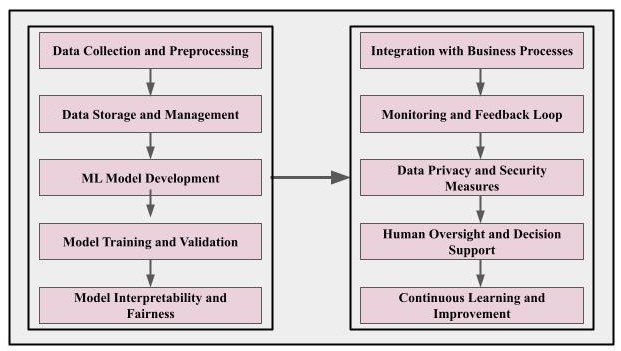A Critical Evaluation of Business Improvement through Machine Learning: Challenges, Opportunities, and Best Practices
Main Article Content
Abstract
This paper presents a critical evaluation of the impact of machine learning (ML) on business improvement, focusing on the challenges, opportunities, and best practices associated with its implementation. The study examines the hurdles faced by businesses while integrating ML, such as data quality, talent acquisition, algorithm bias, interpretability, and privacy concerns. On the other hand, it highlights the advantages of ML, including data-driven decision-making, enhanced customer experience, process optimization, cost reduction, and the potential for new revenue streams. Furthermore, the paper offers best practices to guide businesses in successfully adopting ML solutions, covering data management, talent development, model evaluation, ethics, and regulatory compliance. Through real-world case studies, the study illustrates successful ML applications in different industries. It also addresses the ethical and social implications of ML adoption and discusses emerging trends for future directions. Ultimately, this evaluation provides valuable insights to enable informed decisions and sustainable growth for businesses leveraging machine learning.
Article Details
References
M. Schmitt, “Deep learning in business analytics: A clash of expectations and reality,” Int. J. Inf. Manag. Data Insights, vol. 3, no. 1, 2023, doi: 10.1016/j.jjimei.2022.100146.
T. Hey, “Opportunities and Challenges from Artificial Intelligence and Machine Learning for the Advancement of Science, Technology, and the Office of Science Missions A report for the Advanced Scientific Computing Advisory Committee from the Subcommittee on Artificial Intelligence, Machine Learning, Data-intensive Science and High-Performance Computing,” no. September, 2020.
M. A. Beale and P. H. Franklin, “Using Impact Analysis to Drive Process Assessment and Improvement,” Proc. - Annu. Reliab. Maintainab. Symp., vol. 2018-January, pp. 1–5, 2018, doi: 10.1109/RAM.2018.8462998.
M. U. Tariq, M. Poulin, and A. A. Abonamah, “Achieving Operational Excellence Through Artificial Intelligence: Driving Forces and Barriers,” Front. Psychol., vol. 12, no. July, 2021, doi: 10.3389/fpsyg.2021.686624.
J. M. Puaschunder, “The Potential for Artificial Intelligence in Healthcare,” SSRN Electron. J., vol. 6, no. 2, pp. 94–98, 2020, doi: 10.2139/ssrn.3525037.
G. Volkmar, P. M. Fischer, and S. Reinecke, “Artificial Intelligence and Machine Learning: Exploring drivers, barriers, and future developments in marketing management,” J. Bus. Res., vol. 149, no. April 2021, pp. 599–614, 2022, doi: 10.1016/j.jbusres.2022.04.007.
M. Schmitt, “Automated machine learning: AI-driven decision making in business analytics,” Intell. Syst. with Appl., vol. 18, no. June 2022, p. 200188, 2023, doi: 10.1016/j.iswa.2023.200188.
S. S. Thazhackal and V. S. Devi, “A Hybrid Deep Learning Model to Predict Business Closure from Reviews and User Attributes Using Sentiment Aligned Topic Model,” Proc. 2018 IEEE Symp. Ser. Comput. Intell. SSCI 2018, pp. 397–404, 2019, doi: 10.1109/SSCI.2018.8628823.
A. M. Rahmani et al., “Artificial intelligence approaches and mechanisms for big data analytics: a systematic study,” PeerJ Comput. Sci., vol. 7, pp. 1–28, 2021, doi: 10.7717/peerj-cs.488.
M. M. Najafabadi, F. Villanustre, T. M. Khoshgoftaar, N. Seliya, R. Wald, and E. Muharemagic, “Deep learning applications and challenges in big data analytics,” J. Big Data, vol. 2, no. 1, pp. 1–21, 2015, doi: 10.1186/s40537-014-0007-7.
I. H. Sarker, “Machine Learning: Algorithms, Real-World Applications and Research Directions,” SN Comput. Sci., vol. 2, no. 3, pp. 1–21, 2021, doi: 10.1007/s42979-021-00592-x.
M. Schmitt, “Artificial Intelligence in Business Analytics: Capturing Value with Machine Learning Applications in Financial Services,” 2020, [Online]. Available: https://doi.org/10.48730/5s00-jd45.
R. Jaffari, M. Memon, T. Hafiz, and R. Iftikhar, “Framework of business intelligence systems for infrastructure design and management,” 2017 1st Int. Conf. Latest Trends Electr. Eng. Comput. Technol. INTELLECT 2017, vol. 2018-January, pp. 1–8, 2018, doi: 10.1109/INTELLECT.2017.8277619.
Shanika Wickramasinghe, “Machine Learning Use Cases & Business Benefits,” Https://Www.Bmc.Com/Blogs/Machine-Learning-Can-Benefit-Business/, no. Ml, 2021.
Bhagyashree Pandurang Gadekar and Dr. Tryambak Hiwarkar, “A Conceptual Modeling Framework to Measure the Effectiveness using ML in Business Analytics,” Int. J. Adv. Res. Sci. Commun. Technol., vol. 2, no. 1, pp. 399–406, 2022, doi: 10.48175/ijarsct-7703.
P. R. Chandre, P. N. Mahalle, and G. R. Shinde, “Machine learning based novel approach for intrusion detection and prevention system: a tool based verification,” in 2018 IEEE Global Conference on Wireless Computing and Networking (GCWCN), Nov. 2018, pp. 135–140, doi: 10.1109/GCWCN.2018.8668618.
V. Kuleto et al., “Exploring opportunities and challenges of artificial intelligence and machine learning in higher education institutions,” Sustain., vol. 13, no. 18, pp. 1–16, 2021, doi: 10.3390/su131810424.
Bhagyashree Pandurang Gadekar and Dr. Tryambak Hiwarkar, “From Business Objectives to Analytics and Machine Learning Solutions: A Framework for Conceptual Modeling,” Int. J. Adv. Res. Sci. Commun. Technol., vol. 3, no. 1, pp. 277–285, 2023, doi: 10.48175/ijarsct-7876.
P. Chandre, P. Mahalle, and G. Shinde, “Intrusion prevention system using convolutional neural network for wireless sensor network,” IAES Int. J. Artif. Intell., vol. 11, no. 2, pp. 504–515, 2022, doi: 10.11591/ijai.v11.i2.pp504-515.
M. D. Tamang, V. Kumar Shukla, S. Anwar, and R. Punhani, “Improving Business Intelligence through Machine Learning Algorithms,” Proc. 2021 2nd Int. Conf. Intell. Eng. Manag. ICIEM 2021, pp. 63–68, 2021, doi: 10.1109/ICIEM51511.2021.9445344.

